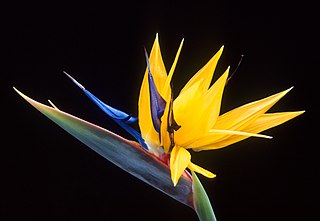
Strelitzia is a genus of five species of perennial plants, native to South Africa. It belongs to the plant family Strelitziaceae. A common name of the genus is bird of paradise flower/plant, because of a resemblance of its flowers to birds-of-paradise. In South Africa, it is commonly known as a crane flower.

The Aizoaceae, or fig-marigold family, is a large family of dicotyledonous flowering plants containing 135 genera and about 1800 species. They are commonly known as ice plants or carpet weeds. They are often called vygies in South Africa and New Zealand. Highly succulent species that resemble stones are sometimes called mesembs.

Strelitzia reginae, commonly known as the crane flower, bird of paradise, or isigude in Nguni, is a species of flowering plant native to the Cape Provinces and KwaZulu-Natal in South Africa. An evergreen perennial, it is widely cultivated for its dramatic flowers. In temperate areas it is a popular houseplant.

Kalanchoe thyrsiflora is a species of flowering plant native to Botswana, Lesotho, South Africa and Eswatini. This plant is rare in cultivation, and those plants labelled as "Kalanchoe thyrsiflora" in horticulture are mostly another similar species, Kalanchoe luciae.

Frithia pulchra, the fairy elephant's feet, is a species of flowering plant in the fig‑marigold family Aizoaceae, endemic to Gauteng Province, South Africa. Its natural habitat is temperate grassland with high summer rainfall. A tiny stemless succulent growing to just 10 cm (3.9 in) tall and 20 cm (7.9 in) broad, it has bulbous oblong leaves with leaf windows at the tip; and magenta and white daisy-like flowers in winter. During periods of drought it has the ability to shrink beneath the soil surface, thus avoiding excessive desiccation, but making it extremely difficult to find.
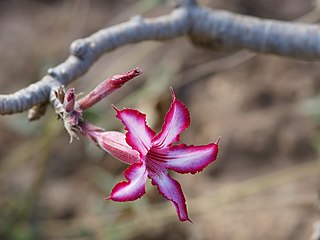
Adenium multiflorum is small, succulent tree native to central and eastern Southern Africa. It may be deciduous or evergreen, and is found in dry woods or grassland in its native habitat. It is typically 0.5-3 m tall. Like other succulent members of the family Apocynaceae, A. multiflorum has a milky latex with toxic alkaloids, specifically Cardiac glycosides. This latex is used as an arrow poison and as a fish stunning poison.

Kumara haemanthifolia is a species of flowering plant in the family Asphodelaceae. It is a rare species of succulent plant, native to a few high, inaccessible mountain peaks in the Fynbos habitat of Western Cape, South Africa.
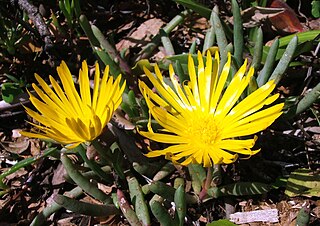
Jordaaniella dubia is a coastal succulent plant of the family Aizoaceae. It is indigenous to the Cape Provinces of South Africa, and is easy to propagate, making an attractive ground cover for coastal gardens.
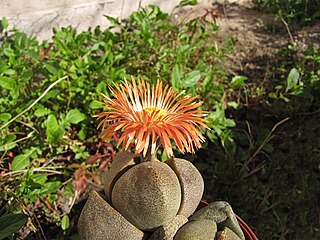
Pleiospilos nelii, the split rock, splitrock or living granite, is a species of flowering plant in the family Aizoaceae, native to South Africa. It grows in semi-arid areas with rainfall of between 150mm and 300mm, in the Karoo of South Africa.
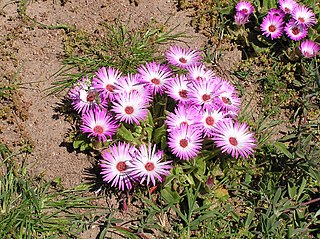
Cleretum bellidiforme, commonly called Livingstone daisy, Bokbaaivygie (Afrikaans), or Buck Bay vygie, is a species of flowering plant in the family Aizoaceae, native to the Cape Peninsula in South Africa. It is a low-growing succulent annual growing to 25 cm (10 in), and cultivated for its iridescent, many-petalled, daisy-like blooms in shades of white, yellow, orange, cream, pink and crimson. In temperate areas it is popularly grown as a half-hardy annual, and lends itself to mass plantings or as edging plants in summer bedding schemes in parks and gardens. It is still widely referenced under its former names, Mesembryanthemum criniflorum and Dorotheanthus bellidiformis.
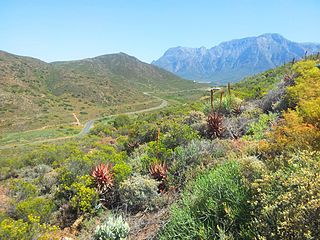
The Karoo Desert National Botanical Garden is a botanical garden focused on succulents and other plants of arid regions, that lies at the foot of the Hex River Mountains range, in the town of Worcester, South Africa.

Gasteria bicolor is a species of succulent flowering plant in the family Asphodelaceae, native to the Eastern Cape, South Africa.

Euphorbia clavarioides, lion's spoor, anthill euphorbia, is a species of herbaceous plant in the family Euphorbiaceae. It is native to Botswana, Lesotho, and South Africa. It may grow to 18 cm in diameter, with a height of 30 cm. Its flowers are yellow.

Orbea variegata is a species of flowering plant in the family Apocynaceae, known as the star flower. It is native to the coastal belt of the Western Cape, South Africa, growing actively during the winter rainfall season. It is an invasive species in southern Australia.

Lithops olivacea is a species of the genus Lithops under the family Aizoaceae. The name olivacea refers to the Latin word for olive (oliva) combined with the suffix -cea, meaning "of the likeness", producing the idea of "olive likeness". Lithops olivacea grow primarily in the Bushmandland of South Africa. They grow most abundantly in the regions of Aggeneys, Pofadder, and Namies. L. olivacea also received the Royal Horticultural Society's Award of Garden Merit for being "excellent for ordinary use in appropriate conditions, available to buy, of good constitution, essentially stable in form & colour, [and] reasonably resistant to pests & diseases."

Colpias is a monotypic genus of flowering plant in the family Scrophulariaceae. It has only one currently accepted species, Colpias mollis, native to South Africa. It secretes oils to attract specialised oil-collecting bees from the genus Rediviva. It is also known by the name klipblom, meaning stone plant in Afrikaans.

Loxostylis is a genus of flowering plants belonging to the family Anacardiaceae.

Crassula ericoides is a species of succulent plant in the genus Crassula native to South Africa. Growing in the fynbos ecosystem of South Africa, C. ericoides somewhat resembles a heather, growing into an upright shrub with bare lower stems and yellow flowers at the tips.
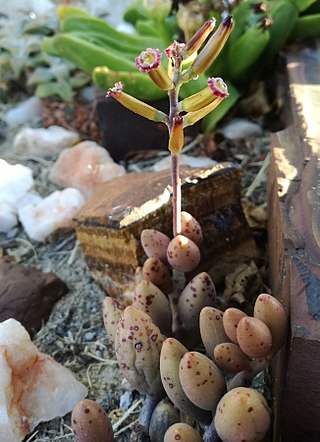
Adromischus filicaulis is a perennial, succulent plant in the family Crassulaceae. It is commonly called brosplakkies in Afrikaans. The species is endemic to South Africa and Namibia.
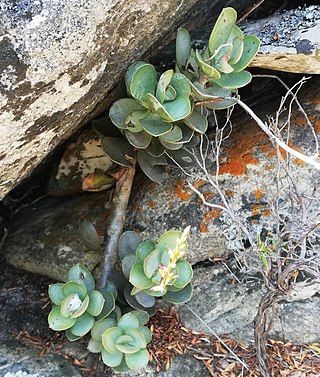
Adromischus hemisphaericus is a perennial, succulent plant in the Crassulaceae family. It is commonly called Brosplakkies. The species is endemic to the Western Cape, South Africa.




















